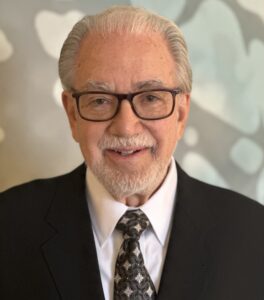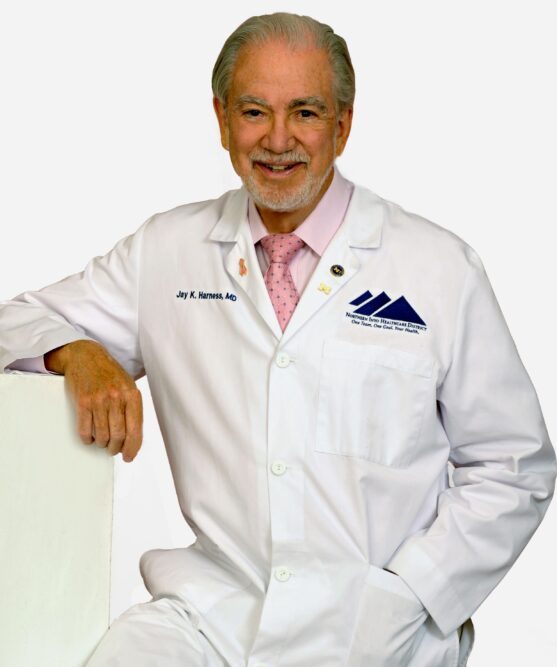 As an authority on breast cancer, Dr. Jay Harness, Arizona ’65, has contributed to several of the innovations now used to treat this disease. Harness, who received his MD from the University of Michigan, was present when the then-groundbreaking approach of using a team of doctors from different specialties to treat breast cancer was first proposed. After volunteering to assist with creating the first breast cancer multidisciplinary treatment team at the University of Michigan Medical Center, he was appointed director of the initiative on the spot.
As an authority on breast cancer, Dr. Jay Harness, Arizona ’65, has contributed to several of the innovations now used to treat this disease. Harness, who received his MD from the University of Michigan, was present when the then-groundbreaking approach of using a team of doctors from different specialties to treat breast cancer was first proposed. After volunteering to assist with creating the first breast cancer multidisciplinary treatment team at the University of Michigan Medical Center, he was appointed director of the initiative on the spot.
“Little did I know that my entire life, my entire career, my entire existence, would change in that moment,” Harness recalled. In the 40 years that have followed, he’s been primarily focused on treating breast cancer. “That model of a multidisciplinary team — composed of surgeons, medical oncologists, radiation oncologists, physical therapists and others—is the standard of cancer care today,” he explained. Since then, he‘s spent his career establishing other multidisciplinary breast cancer programs in Massachusetts and California, all while teaching at leading medical schools and advocating for the use of diagnostic procedures such as ultrasound to assess tumors before and during surgery. He’s also written books on innovative approaches to treating breast cancer.
Now, the renowned surgeon is pursuing a passion project he believes will have a meaningful impact on the health of millions of Americans. As chief medical officer of Maple Tree Cancer Alliance, an organization that works with medical centers to develop personalized exercise programs for cancer patients, Harness is on a mission to include exercise as part of the standard treatment for patients with a wide range of cancers.
Even with his decades of expertise, Harness is relatively new to this area of healthcare. About seven years ago, he met Andrea Leonard, a cancer survivor and personal trainer who’s been one of the leading proponents of exercise oncology. She shared anecdotal evidence of the many instances that exercise positively affected her clients. Harness was intrigued. But ever the scientist, he asked Leonard for the hard data to back up her experiences.
Turns out, the evidence was plentiful. So, why wasn’t Harness, an experienced surgical oncologist, aware of the benefits exercise could bring to his patients? Most of the research in this area hasn’t been conducted by medical doctors, but rather by PhDs in kinesiology, exercise physiology, sports medicine and immunology. Simply put, the PhDs and the MDs hadn’t been communicating on this important topic until recently.
Enter Harness, who is bridging that gap. He’s spent the last few years educating his colleagues, as well as patients, about how exercise can improve outcomes for those living with cancer. One benefit, he noted, is that patients respond better to chemotherapy. “There’s a better tolerance of chemotherapy. There’s a little less nausea and vomiting, less anxiety, and less depression, among other benefits.”
 He said aerobic exercise for 30 minutes five times a week, along with resistance training twice a week, have been shown to lower the likelihood of disease recurring in his specialty of breast cancer. There’s also evidence that maintaining this exercise regimen improves survival rates for many other types of cancer and lowers the chance of cancer patients dying from something else, like heart disease or stroke, by 30 to 40 percent.
He said aerobic exercise for 30 minutes five times a week, along with resistance training twice a week, have been shown to lower the likelihood of disease recurring in his specialty of breast cancer. There’s also evidence that maintaining this exercise regimen improves survival rates for many other types of cancer and lowers the chance of cancer patients dying from something else, like heart disease or stroke, by 30 to 40 percent.
It’s important to emphasize that exercise and exercise oncology programs aren’t replacements for standards of care like surgery, chemo/endocrine therapy and radiation therapy. Exercise helps patients, among other things, tolerate these therapies better. Harness is not only spreading this message to physicians and patients who fight cancer every day, he’s going a step further. He’s advocating for the U.S. to follow the lead of Australia, which has made exercise a standard component of cancer treatment. He’s supporting a proposal by a team of medical associations, including the American Cancer Society, to create billing codes that will enable medical centers to receive reimbursement from insurers for “prescribing” exercise—just like they do for other appointments and procedures.
If the codes receive the green light, “That will open up the floodgates of interest on the part of cancer centers and providers here in the United States,” Harness explained with excitement. Not content to address exercise oncology on just one or even two fronts, Harness is working on a proposal for a documentary series that will increase awareness about exercise programs for various cancers and treatments. He’s also launched Cancer Fitness, an educational website for cancer patients and cancer providers (cancerfitness.org).
The SigEp Citation recipient was particularly excited to share news of his current efforts around exercise oncology with the Journal due to the Fraternity’s philosophy of Sound Mind, Sound Body and commitment to promoting healthy habits. “If we had a much higher percentage of the American population simply following SigEp’s concept of Sound Mind, Sound Body,” Harness stated, “we’d have less heart disease, less cancer, less dementia. We’d have less of a lot of these things because it is really a lifestyle model.”









Leave a Reply